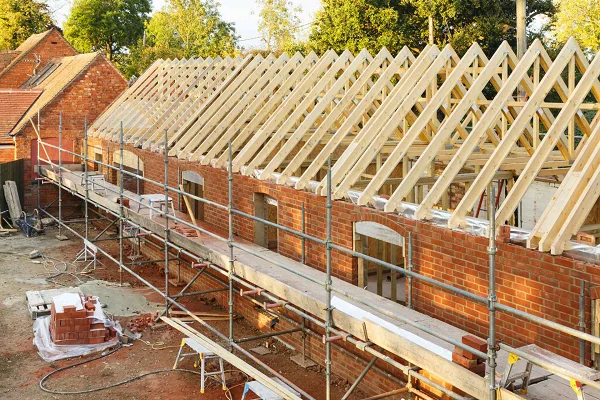Bridging Loan Borrowing Is Up 22%, But Why?
All indications point to another buoyant year for bridging finance, following another major spike in loan applications. On the whole, the total value of the UK’s bridging sector has grown by as much as 22% over the past 12 months alone. More private borrowers and commercial customers are taking out bridging loans than ever before, but why?
Bridging finance differs from most conventional loans and mortgages in that it is a strictly short-term facility. Typically issued over a term of 12 months or less, bridging finance is also comparatively quick and easy to arrange. With all the essential paperwork and supporting documentation in place, the funds that are needed can be accessed within a few working days.
Coupled with monthly interest as low as 0.5%, the appeal of bridging finance is easy to understand; the more difficult and expensive it becomes to borrow money from major High Street banks, the more business flows the way of the UK’s thriving bridging sector.
A major spike in loan completions and applications
The most recent raft of figures suggests that between Q1 and Q2 this year, total bridging loan values swelled from £156.8 million to £178.4 million. This represents a growth of 13.8% over the course of three months alone. Year-on-year, total lending volumes skyrocketed by approximately 21.8% between Q1 2021 and Q2 2022.
Even so, there is still some way to go until the sector reaches pre-pandemic performance, having hit an all-time record performance of £180.9 million in Q4 2019.
As for why so many people are taking their business to bridge loan specialists, purchasing investment properties remains the single most common application for bridging finance. Following the trend of several previous consecutive quarters, investment property purchases once again accounted for almost a quarter of all bridging loans taken out in Q2 this year. This includes landlords purchasing properties to let out to tenants and investors looking to flip homes for capital gains.
Meanwhile, 21% of bridging loans issued in Q2 were used to help homebuyers break out of property chains. With competition in the housing market at an all-time high, more homeowners than ever before are using bridging finance to tap into the equity they have tied up in their homes and beat competing bidders to the punch.
Funding significant property improvements and refurbishments remained a popular use for bridging finance during Q2, accounting for around 30% of all loans issued.
A gradual decline to come?
Speaking on behalf of Henry, Director Geoff Garrett suggested that while the immediate outlook for the bridging sector is bright, the coming months could bring a gradual slowdown in overall activity.
“An increase in bridging loans does not signify that people are struggling financially. Such loans are taken in order to fund major purchases or investments but can only be granted to people who can prove they have larger, longer-term loans coming their way, such as a mortgage,” he said.
“Instead, an increase in bridging loan totals indicates that the systems in place are struggling to keep up with demand and can’t match the desired pace of buyers and sellers. The housing market, for example, is moving more slowly than it did a year ago, even two and three years ago. At the same time, buyer demand is extraordinarily high, and activity is through the roof. This causes delays in the conveyancing and buying process, which, in turn, increases the need for bridging loans.”
“However, with the cost of living and interest rates rising so rapidly, one has to expect to see a slight drop-off in buyer demand and, therefore, a decline in bridge financing over the next year or so.”
Money Saving Expert Bridging Loans: What’s the Verdict?
For some time, Money Saving Expert has been the UK’s go-to for honest and impartial advice on the most essential financial topics. Along with the useful resources published by the MSE team itself, the website also has a forum with more than two million active members.
But what is the official (or unofficial) Money Saving Expert’s take on bridging loans? Does the Money Saving Expert website offer any advice, direct or otherwise, for those looking into bridging finance?
What is a money-saving expert?
Established in 2003, Money Saving Expert was created by Martin Lewis, a financial journalist who would eventually make his own fortune helping other people save money. He’s now worth tens of millions of pounds, but he can still be found regularly advising folks on how to save money on their household bills and other outgoings in general.
Money Saving Expert is staffed by more than 100 people who create and curate a steady stream of consumer-finance-related posts. Martin Lewis himself has become known as something of a guru on the financial advice scene and is constantly popping up in high-profile slots on popular TV and radio shows.
He sold Money Saving Expert to the Money Supermarket Group several years ago for a massive sum of money, but he still contributes to its output.
What does a money-saving expert say about bridging loans?
Interestingly, bridging finance is not a topic that has ever been brought up on Money Saving Expert in any official capacity. In fact, there has barely been any mention of bridging finance from the Money Saving Expert team itself over the years.
The same can also be said for Martin Lewis, who so far has remained fairly tight-lipped regarding his thoughts on bridging finance. Perhaps due to the fact that bridging loans have only recently started to become mainstream in nature, having previously been near-exclusively available to established business borrowers.
What is a bridge loan?
A bridging loan is a type of short-term finance that typically lasts 12 months or less. It will provide you with an instant cash boost while you wait for longer-term finance. Bridging finance is often used by people who want to purchase a property but have yet to sell their present household.
If you choose to take out a bridging loan, you can do so from traditional lenders, such as high-street banks, or through a finance broker, such as UK Property Finance. Keep in mind that a bridging loan will be secured against an asset; this is usually your property. If you don’t meet any of the repayments, your home could be at risk.
How about the money-saving expert forum?
It is a slightly different story where the Money Saving Expert forum is concerned, where literally thousands of conversations have taken place to date about bridging finance.
All of this makes it surprising that little to no information or guidance has been published by Money Saving Expert.
Taking a look at the Money Saving Expert forum sheds light on some of the most common questions and concerns regarding bridging finance. For example, some of the most frequently asked questions of all by members of the Money Saving Expert forum include the following (and variations thereof):
- Will I qualify for bridging finance?
- Who can apply for a bridging loan?
- What does the bridging loan application process look like?
- What security needs to be provided for a bridging loan?
- How are bridging loans repaid?
- Can a bridging loan be repaid on a monthly basis?
- Is it possible to get bridging loans with bad credit?
This would seem to suggest that general interest in bridging loans among the consumer audience has been piqued for some time. However given the lack of formal input from bridging loan experts, advice sourced from forums like these is not always reliable.
Ask the experts…
Of course, this is not to say that forums like these cannot be useful for accessing invaluable information. Particularly when it comes to people’s first-hand experiences with bridging finance, there’s much to learn in public forums.
But if you have important questions or concerns to raise regarding bridging finance, they should always be discussed with an expert. Book your obligation-free consultation with the team at UK Bridging Loans today, and we will help you build a clear picture of the pros and cons of short-term borrowing.
Jade Buswell Nominated for Outstanding Senior Female Executive of the Year 2022
She is the outstanding senior female executive of the year 2022 (East Midlands).
At UK Property Finance, we are always delighted to receive positive feedback for the services we provide. We are particularly proud when a member of the UK Property Finance team is recognised for their achievements and their contributions to the industry we work in.
That is why it is with huge pride and pleasure that we announce that our own Jade Buswell has been nominated for the ‘Outstanding Senior Female Executive of the Year’ award at the 2022 Women’s Awards. And it is with even greater pride that we can confirm Mrs Buswell has been shortlisted for the final stages of the competition.
Outstanding senior female executive of the year 2022 (East Midlands)
“The Women’s Awards are a prestigious multidisciplinary award celebrating the outstanding achievements of women. The purpose of these awards is to raise awareness, recognise, and honour the hard work and valuable contribution women of all cultures, communities, races, and beliefs in all sectors make. 2022 is our sixth year as we continue to grow. There are many ways to get involved, least of all through making a nomination or sponsoring an award category. Become part of the movement to help women see their worth.” The Women’s Awards
According to the organisers of the Women’s Awards, the Outstanding Senior Female Executive of the Year category is dedicated to individuals who have held senior roles within organisations for a minimum of three years and are able to demonstrate the outstanding impact they have had on both their company and its workforce.
Shortlisting for the Outstanding Senior Female Executive of the Year award (for the East Midlands) took place in late July, and we are now counting down to the Women’s Awards Gala Dinner and Presentation set to take place later this year.
The event has been scheduled for Friday, September 9th, and will be held at Colwick Hall in Nottingham. Special guests set to make an appearance at the ceremony include Her Majesty’s Lord-Lieutenant of Nottinghamshire, Sir John, and Lady Peace, and tickets are already on sale via the following link:
Huge congratulations from the team at UK Property Finance.
Once again, we would like to congratulate Mrs. Buswell on her nomination for Outstanding Senior Female Executive of the Year and express our gratitude to all those who have supported UK Property Finance over the years.
For more information on any aspect of our business or the financial services we provide, contact a member of the team anytime for an obligation-free consultation.
Land Mortgages: An Introductory Guide
Getting a land mortgage is rarely a straightforward task. This is mainly due to a lack of available options, as most major lenders offer comparatively few (if any) specialist loans for land.
Hence, shopping around for a great deal on a landlord mortgage typically means looking beyond the usual High Street banks.
The UK’s specialist lending community has a wide variety of loan options available for land purchases. Examples of this include development finance loans, bridging loans, commercial loans, and various other types of secured loans.
However as many of these lenders do not offer their services directly to borrowers, applications must be submitted via an approved broker.
Can I get a mortgage for land?
Yes, land mortgages are available from a wide variety of specialist lenders. However, qualifying for a land mortgage can be more difficult than obtaining a conventional mortgage.
With a traditional home loan, the funds are secured against the property you are purchasing. With a land mortgage, the property has not yet been built. Therefore, if the lender issues a loan that also covers the costs of building the property, they are taking a much bigger risk.
Lenders, therefore, need to see evidence of what the borrower intends to do with the land after it has been purchased. A full independent valuation of the proposed property or development must also be provided, which will be used as the basis for the maximum loan value issued.
What are the different land mortgage options available?
Specialist lenders offer a variety of different types of land mortgages, in accordance with the requirements of the applicant. Examples of these include:
- Self-build mortgages
- Agricultural mortgages
- Woodland mortgages
- Development Finance
Ensuring you apply for the right mortgage is essential in order to get the best possible deal. If in doubt, consult with an independent broker, who will ensure you understand the unique features of the land mortgage options available.
Do I need to get planning permission ahead of time?
Not necessarily, but it will certainly broaden your borrowing options. When planning permission is granted on a plot of land, its value increases significantly. It also reassures the lender that your plans for the land can go ahead.
Obtaining a mortgage for land without planning permission is still possible but can be much more difficult. If you intend to apply for planning permission in the future or have other plans for the land you are purchasing, your broker will advise on the appropriate loan options.
What are the different types of planning permission for land?
There are two main types of planning permission that can be obtained for a plot of land. Both of which could significantly boost your chances of qualifying for a competitive mortgage:
Outline planning permission (OPP)
This is an agreement in principle issued by the local council, where one or more dwellings are to be constructed on a plot of land. OPP agreements are valid for a limited period of time (typically three years) and will need to be renewed once they have expired.
In order to qualify for a land mortgage after obtaining planning permission, your lender will expect to see formal evidence of the following:
- The overall layout of the proposed dwelling(s)
- The appearance of the dwelling(s)
- Upper and lower limits for the height, width, and length of the dwelling(s)
- Site access details
- Landscaping proposals
Full planning permission (FPP)
Typically valid for a longer five-year period, full planning permission is granted upon meeting more extensive criteria. An application for FPP must satisfy all the requirements above, supplemented with detailed scale drawings of the property (or properties) and more detailed information.
FPP is always desirable in the eyes of lenders, as it adds considerable value to any plot of land. With FPP, a plot of land becomes more attractive to potential buyers, making it a safer asset to secure a loan or mortgage against.
What needs to be in my financial plan?
A detailed financial plan will need to be presented as part of your application. This is essentially a summary of all estimated construction costs, along with estimated labour costs, the logistics of how the property will be constructed, contractors who will be involved in the project, and so on.
Essentially, this is where you need to convince your lender that your project is not only viable but also economically sound. In addition, almost all lenders impose restrictions on the types of properties they will lend against and even the materials they are made of.
For example, brick-built properties are the only acceptable properties for some lenders.
Your financial plan, therefore, needs to be as detailed and comprehensive as possible. The clearer you outline your intentions and the specifics of your project, the more likely you are to qualify for funding.
How do land mortgages work?
Land mortgages work similarly to development finance loans, in that the funds are released in a series of stages. For example, the first instalment may be released to cover the costs of the land itself, followed by several subsequent instalments for key phases of the construction project.
This involves the use of surveyors hired by the lender to monitor the progress of the project. When the bank is satisfied that a key phase of the project has been completed, they will release the next instalment.
It is also possible to arrange a land mortgage that is paid in the form of a single lump sum. Bridging loans, for example, can be arranged and accessed in a matter of days, making them ideal for time-critical purchases and investment opportunities.
When the construction project is complete, the land mortgage can be repaid in the same way as a conventional mortgage. Or, in the case of a shorter-term facility, transition to a longer-term repayment loan.
There’s also the option of selling the property upon its completion in order to repay the loan in full and retain the profits.
How high are land mortgage rates?
Interest rates on land mortgages vary significantly from one product and provider to the next. As a general rule of thumb, the lowest rate you can expect to be offered is around 3%, but a more typical land mortgage rate would be around 4.5%.
With short-term funding options like bridging finance, interest is charged on a monthly basis, often as low as 0.5%. This could make a promptly repaid bridging loan a uniquely cost-effective facility, with no additional fees or penalties payable for early repayment.
How are land mortgage fees charged?
Additional borrowing costs vary on the basis of multiple factors, including the type of mortgage taken out and the issuer.
As with any mortgage, you will incur fees that you will need to consider before applying, such as:
- Application Fees: Also known as arrangement fees, processing fees, and admin fees, which can be anything from zero up to 2% of the value of the loan,
- Valuation Fees: The lender will want to see a formal valuation of the project’s estimated final value, provided by an approved surveyor and paid for by the borrower.
- Legal Fees: All legal fees and conveyancing fees must also be covered by the applicant, which may be charged as a flat fee or a percentage commission on the value of the loan.
Comparing the market with the support of an experienced broker holds the key to getting an unbeatable deal, irrespective of the type of land mortgage you apply for.
Can land be refinanced?
It is always advisable to consider refinancing options as soon as the project is complete. This is due to the fact that interest rates and borrowing costs on land mortgages have a tendency to be higher than those of conventional mortgages.
If the home (or homes) constructed on the land qualify for a standard residential mortgage, significant savings could be made. However, even bigger savings could be made by using a short-term facility (such as a bridging loan) to cover the costs of the project and repay the full outstanding balance as quickly as possible.
For more information on any of the above or to discuss land mortgages in more detail, contact a member of the team at UK Property Finance today.
Buy-to-Let Property Investments: What First-Time Landlords Need to Know
Established and aspiring landlords alike continue to question the potential benefits of purchasing BTL properties via a limited company. Understandable, given the government’s no-holds-barred approach to BTL legislation over recent years.
Landlords were first hit (and hard) back in 2016, when the government introduced a new 3% stamp duty level on BTL property purchases. Next, policy reforms slashed mortgage and loan interest relief on second homes, which would eventually be removed entirely by 2021.
2019 brought more bad news for landlords in the form of the Tenants Fees Act, imposing much greater restrictions on what tenants could and couldn’t be charged for by property owners.
Whichever way you look at it, turning a profit as a private landlord is becoming trickier all the time. But as demand for quality rental homes skyrockets and average monthly rents break every record in the books, there’s still good money to be made with savvy BTL investments.
In total, the value of the UK’s BTL sector has grown from £239 billion in 2017 to more than £1.7 trillion today.
“There have been many challenges that have subdued investment into the private rental sector over the past few years,” comments Stephen Clark a bridging finance broker.
“But the sector has proved resilient, and we have seen continued demand for finance in this vibrant part of the economy.”
Safety and stability
The property market, in general, remains a relative safe haven for investors. Even the catastrophic events of the past two years have done nothing to quell the public’s appetite for quality homes in desirable locations.
In fact, figures from Nationwide suggest that from March 2020 to December 2021, average house prices in the UK grew by more than 16%.
Responding to demand from homebuyers and investors alike, major banks have been diversifying their mortgage portfolios as of late. BTL mortgage products, in particular, are available in abundance; there were more than 2,235 specialist mortgages at the end of last year.
What’s more, many banks have also been cutting interest rates on five-year fixed mortgages for BTL borrowers as a means to encourage more landlords to make their moves.
“The BTL sector has faced its share of upheaval and changes to regulations and requirements, so it is highly encouraging to see that providers are still keen to attract first-time landlords,” said Eleanor Williams at Moneyfacts.
“Rents have risen at the fastest rate on record, while tenant demand has almost doubled.”
Still, with inevitable Bank of England base rate hikes on the cards, mortgages across the board are not going to get any cheaper than they are now.
But when it comes to maximising profits and minimising tax liability on a BTL property, is it better to purchase homes through a limited company?
The pros and cons of limited company investments
Forming a limited company to purchase real estate is not something that should be done without careful forethought. In addition, the advice and input of an experienced broker could prove invaluable.
From a general perspective, the benefits of using a limited company to purchase a BTL property are as follows:
- All profits generated on limited company BTL property purchases are subject to flat-rate corporation tax at 19%. By contrast, private landlords are subject to standard income tax bands, which are 20% in the normal band and up to 45% for higher-rate taxpayers.
- Mortgage interest is classified as a business expense for limited companies, meaning it is tax-deductible. For private landlords, a tax credit of just 20% can be claimed on mortgage interest payments.
- Revenue withdrawal options are also broader. All profits received by private landlords are taxed, whereas profits taken out of limited companies are only taxed once.
- There are also options for decreasing overall tax liability, such as forming a family investment firm or a limited liability partnership. Assets can also be transferred to family members to avoid or reduce inheritance tax.
Downsides also apply with limited company BTL investments, including the following drawbacks:
- Mortgage options are much more limited for businesses looking to purchase BTL properties, and it can be more difficult to qualify.
- Larger deposits are the norm for these kinds of property investments, along with higher rates of interest and elevated borrowing costs.
- Along with corporation tax, dividends withdrawn from the company are also taxable.
- In order to transfer a property you already own into a company holding, it needs to be sold in the normal way. This means paying stamp duty at the normal rate, along with all associated conveyancing and legal fees, plus capital gains tax.
Despite this fairly even split of pros and cons, more landlords are purchasing properties through limited companies than ever before. In fact, the figures suggest that around 80% of all BTL mortgages are being issued to limited companies.
“Getting the ownership structure right might make a tremendous difference in the amount of tax you pay throughout your lifetime,” commented Rob Dix (the Property Geek).
As a general rule of thumb, experts advise considering forming a limited company where a landlord has a minimum of three private rental properties. By contrast, landlords with two properties or a single rental home may find it more cost-effective to simply hire an accountant to oversee their affairs.
What is Stamp Duty (and How Can a Bridging Loan Help)?
With the Stamp Duty holiday having officially ended, normal rates have resumed. This means that both first-time buyers and movers alike must once again factor Stamp Duty costs into their property purchase decisions.
What is stamp duty?
Getting to grips with the fundamentals of Stamp Duty is fairly straightforward, but essential nonetheless. Stamp Duty is payable on millions of property transactions each year, but not everyone is liable for Stamp Duty payments.
For example, residential property buyers in England and Northern Ireland pay no Stamp Duty on the first £125,000 of the property’s value. In addition, first-time buyers pay no Stamp Duty on the first £300,000 of their home’s market value.
After which, 5% is payable on the price of the property between £300,000 and £500,000. Higher rates apply for properties valued at £500,000 or more.
This means that most first-time buyers are not liable for Stamp Duty payments at all, with most property transactions in the UK falling below £300,000.
Different rules apply in Wales, where Land Transaction Tax is payable on homes valued at £180,000 or higher. Likewise, homes valued at £145,000 or more (or £175,000 for first-time buyers) are subject to Land and Buildings Transaction Tax in Scotland.
But what remains consistent across the board is the requirement to pay this property purchase tax as quickly as possible. You have just 14 days to make the payment in full, which is where a fast-access bridging loan could get you out of a bind.
Stamp duty on second homes
Existing homeowners purchasing a second property in England or Northern Ireland with a value in excess of £40,000 are liable for an additional 3% Stamp Duty payment (on top of the normal sum).
This applies to holiday homes, buy-to-let properties and second homes in general, but does not apply to houseboats, caravans and other non-static homes.
This higher-rate Stamp Duty may also be payable if you complete the purchase of your next home before selling your current home. However, you will be able to apply for a refund of this additional 3% Stamp Duty once the sale of your previous home is complete.
If you need a temporary financial solution to ‘bridge’ the gap between buying and selling, an affordable bridging loan could be just the thing.
Call UK Property Finance anytime to discuss the potential benefits of bridging loans in more detail.
Current stamp duty thresholds
As of October 1st 2021, the following Stamp Duty threshold came into effect for most homebuyers in England and Northern Ireland:
|
Proportion of property value |
Stamp Duty paid |
|
Up to £125,000 |
0% |
|
£125,001 – £250,000 |
2% |
|
£250,001 – £925,000 |
5% |
|
£925,001 – £1.5m |
10% |
|
£1.5m+ |
12% |
Land Transaction Tax (LTT) applicable in Wales as of July 1st 2021 are as follows:
|
Property value |
Land Transaction Tax paid |
|
£0 – £180,000 |
0% |
|
£180,001 – £250,000 |
3.5% |
|
£250,001 – £400,000 |
5% |
|
£400,001 – £750,000 |
7.5% |
|
£750,001 – £1.5m |
10% |
|
£1.5m+ |
12% |
Home purchases in Scotland are currently subject to Land and Buildings Transaction Tax (LBTT) at the following rates:
|
Property value |
Land and Buildings Transaction Tax paid |
|
£0 – £145,000 |
0% |
|
£145,001 – £250,000 |
2% |
|
£250,001 – £325,000 |
5% |
|
£325,001 – £750,000 |
10% |
|
£750,001+ |
12% |
Stamp duty on buy-to-let properties
Private landlords have been hit particularly hard by recent tax reforms in the UK and are also subject to higher Stamp Duty payments than conventional homebuyers.
A 3% surcharge now applies on all BTL property purchases valued at £40,000 or over – a full breakdown of current thresholds is as follows:
|
Proportion of property value |
stamp duty paid |
|
Up to £125,000 |
3% |
|
£125,001 – £250,000 |
5% |
|
£250,001 – £925,000 |
8% |
|
£925,001 – £1.5m |
13% |
|
£1.5m+ |
15% |
Buy-to-Let properties are subject to different taxation rules in Wales and Scotland – the respective information for which can be found on each country’s official government website.
Bridging loans for stamp duty payments
It is a legal requirement to meet HMRC’s Stamp Duty demands within 14 days of a property purchase being agreed upon. After this, significant penalties may be payable, increasing as the debt remains unpaid.
This is where affordable bridging finance has the potential to save homebuyers time, money and stress. If difficulties are encountered covering Stamp Duty obligations, a short-term bridging loan offers an ideal solution.
Unlike most conventional loans, bridging finance can be arranged within a few working days. This makes it ideal for covering time-critical expenses, where delays could lead to further costs and complications.
In the case of Stamp Duty, a bridging loan could be taken out to cover the required payment and repaid after a few months. Bridging finance is typically charged at a rate of around 0.5% per month, making it a uniquely cost-effective facility when repaid promptly.
A few common features of bridging loans:
- Funds can be arranged and accessed in a few days
- Loans available from £10,000 with no upper limits
- No monthly repayments or initial deposit
- Interest rates as low as 0.5% per month
- Open to poor credit applicants and self-employed workers
- Can be secured against most types of properties
- Ideal for time-critical tax payments
Bridging loans are issued primarily on the basis of two things – security for the loan and a viable exit strategy. In the case of Stamp Duty payments, most bridging loans are repaid when the borrower’s previous home sells, or with personal savings accrued over the course of several months.
It is even possible to repay bridging finance with a conventional unsecured loan or personal loan, which can then be repaid gradually with affordable monthly instalments.
If you have any questions or concerns regarding your capacity to meet your Stamp Duty obligations, call UK Property Finance anytime for an obligation-free consultation.
What other purposes can bridging loans be used for?
The beauty of bridging finance lies in its versatility, as the funds can be used for almost any legal purpose.
Just a few of the most common applications for bridging loans in the UK include the following:
- Escaping the property sales chain
Bridging finance can grant existing homeowners the spending power of a cash buyer when looking to relocate. Rather than relying on the sale of their current home to fund their move, they can buy their next home with a bridging loan and repay the facility at a later date when their previous home sells.
- Renovations, restorations and conversions
Sellers intent on selling their properties for the best possible price often conduct repairs and renovations, prior to putting them on the market. Bridging loans are commonly used to fund minor, moderate and major renovations to residential properties, with the aim of repaying the loan when the property sells for an agreeable price.
- Auction property purchases
Buying a low-cost property at auction means paying the full outstanding balance within 28 days; as bridging finance can be organised within a few working days, it is ideal for funding time-critical purchases and investment opportunities like these.
- Fast purchases
It could also simply be that you have found your dream home at an unbeatable price, and you would prefer not to be beaten to the punch by a competing bidder. With bridging finance, rapid property purchases are possible without having to rely on conventional loans or mortgages.
- Starting a business
Bridging finance also has an endless range of business and commercial applications. Many borrowers use bridging loans to raise the funds needed to start a new business, repaying the loan at a later date when their start-up begins turning a profit. Lending criteria for bridging finance are fairly relaxed, making it ideal for entrepreneurs with no provable experience or track record.
How can I get a bridging loan?
The key to getting a good deal on a bridging loan lies in seeking experienced broker support at an early stage. Your broker will help determine your suitability for bridging finance before scouring the market to find the perfect product for your needs.
They will also negotiate on your behalf to ensure you get an unbeatable deal while ensuring your application is processed as quickly and smoothly as possible.
For more information on any of the above or to discuss the benefits of bridging finance in more detail, contact a member of the team at UK Property Finance today.
How Can Bridging Finance Help During Divorce Proceedings?
Far from a rarity, divorce is becoming more commonplace than ever before. In fact, research suggests that a full 33% of all UK marriages end in divorce. Separation is always emotionally fraught and logistically complex, but it can also be surprisingly expensive.
This is particularly true in instances where one partner owes the other a significant sum of money or where there are marital assets that cannot be divided equally. For example, if one of the partners wishes to keep ownership of the house they shared after the other leaves.
The financial complications associated with divorce often take separating partners by surprise. Little to no specialist support is available on the High Street but can be sourced from elsewhere from established independent lenders.
Bridging finance in particular can be useful when dividing assets and consolidating expenses due to its flexibility and prompt accessibility.
Financial support during a divorce
Every separation is unique, and the financial complications of divorce differ significantly from one couple to the next. Some partners split amicably and come to agreements on asset division with no outside intervention. Elsewhere, others face the unsettling process of dividing a long list of marital assets, which, in the case of tangible property and possessions, often cannot be split down to the middle.
The definition of ‘marital’ assets is also somewhat open to interpretation in terms of the proportion of any given asset that belongs to each of the partners. Legal support and even court intervention are often required in order to determine who owns what and how joint assets should be split.
At this point, it may become necessary for one of the partners to pay the other a large lump sum of money. This could be to ‘buy them out’ of the home they once shared, to take full ownership of a shared car, and so on.
Conventional loans and mortgages can be too complex and time-consuming to arrange for such purposes, whereas a specialist bridging loan can often be accessed within a few working days.
The role of divorce loans
A divorce loan is a special type of bridging finance issued for these exact purposes. As the name suggests, the facility is designed to ‘bridge’ urgent yet temporary financial gaps while the borrower gets their financial situation back on track.
With divorce, one thing both partners are always in agreement on is the importance of a prompt resolution. Nobody wants separation proceedings to drag on for months, but this is often the case where financial complications prove burdensome.
Bridging finance can be used for any legal purpose and provides borrowers with the opportunity to quickly liquidate assets for division. It can also be a useful facility for clearing debts with a former spouse or for buying them out of jointly owned assets.
For example, a bridging loan could be taken out against a co-owned property at an LTV of 50%. By accessing 50% of the equity tied up in the property, the partner who will continue living there can pay off their ex-spouse and take full ownership of their home.
This bridging loan will then accrue interest at a rate as low as 0.5% per month, giving the borrower plenty of time to consider the options available. They could sell the home to pay off the loan a few months later or transition the bridging loan to a longer-term mortgage for flexible repayment.
The overriding point is that with bridging finance, everything can be taken care of as quickly as possible. Rather than waiting weeks (or even months) for a major bank to reach a decision on a loan or mortgage application, the funds needed to bring the matter to a swift conclusion can be accessed in a matter of days.
How does bridging finance for divorce work?
Bridging finance for divorce works in the same way as conventional bridging finance.
A few of the key features of bridging loans for divorce (and other purposes) are as follows:
- Loans available from £20,000 with no upper limit
- Repaid in a single lump sum after 6 to 18 months
- Can be used for any legal purpose whatsoever.
- Competitive loans are available for poor credit applicants.
- No proof of income or employment status is required.
- Monthly interest as low as 0.5%
- Loans can be arranged and accessed within a few working days.
- Available with LTVs as high as 85%
- Can be secured against any type of property (and other assets).
- No arrangement fees or exit fees
Essentially, bridging finance works similarly to a mortgage, but on a much shorter-term basis. The loan is arranged in a matter of days, and the facility is repaid in full within months.
During time-critical situations where financial matters need to be resolved as quickly as possible, bridging finance offers a practical and affordable solution.
For more information on any of the above or to discuss divorce finance in more detail, contact a member of the team at UK Property Finance today.
What is a bridge loan?
Bridging loans are short-term secured loans that can be used for any legal purpose. They are secured against assets of value in the same way as a mortgage, but are much quicker to arrange and are designed to be repaid within 6 to 18 months. As the name suggests, bridging finance is designed to “bridge” temporary financial gaps.
How long does it take to get the funds?
With all the required documentation and supplementary evidence in place, a bridging loan can be arranged in a matter of days. Completion times vary from 1 to 14 working days, depending on the borrower’s requirements and the strength of their application. Broker support can significantly accelerate the speed and simplicity of bridging finance applications.
Can I still get a bridging loan with bad credit?
Yes, bridging loans are issued primarily on the basis of security, along with the applicant’s proposed exit strategy. If you have assets of value (like your home) to cover the costs of the loan and a plan to repay the balance in full by an agreed date, you can get a bridging loan, irrespective of your credit status.
Can self-employed workers qualify for bridging finance?
Yes, employment status and proof of income are not ‘binary’ eligibility criteria for bridging finance. If you have viable assets of sufficient value to cover the costs of the loan and can comfortably afford to repay the balance in full by the agreed-upon date, your employment status is not important. However, it is important to enlist broker support at an early stage in order to ensure you target the right lenders with your applications.
What type of security is required?
Most bridging loans are secured against properties owned by the applicant. These can be residential properties, commercial properties, and all types of mixed-use properties, along with land (with or without planning permission). Some lenders are also willing to accept other assets of value or security, including business equipment, cars and commercial vehicles, jewellery, watches, and even company shares.
For more information on any of the above or to discuss any aspect of divorce finance in more detail, contact a member of the team at UK Property Finance today.
Bridging Loans for Property Development: How Does it Work?
Specialist development finance is a popular choice for property developers and construction companies, providing prompt access to significant sums of money for extensive and ambitious projects.
However, there are scenarios where a bridging loan for property development could be a better choice. Unlike development finance, bridging loans are issued in the form of a single lump sum. Not released in a series of stages as the project progresses. In addition, qualifying for a bridging loan can be fairly straightforward, whereas development finance is offered exclusively to established property developers.
But how does a development bridging loan work, and what are its key features? More specifically, what makes a bridging loan for property development a better choice than a standard commercial loan or mortgage?
Typical applications for property development bridging loans
A bridging loan can be used for any legal purpose, with few restrictions as to the potential applications for the funds. Some of the more common uses of property development bridging loans are as follows:
- To pick up low-cost properties at auction and to fund the subsequent renovations required.
- To purchase a plot of land quickly and beat rival bidders to the punch.
- To commence and complete a project as quickly as possible when time is a factor
- To fund any kind of property development project as a new or experienced developer.
Property development bridging loans can also be a useful facility for subprime applicants who would otherwise be unable to qualify for a conventional property loan or mortgage.
How does a development bridging loan work?
A development bridging loan is a strictly short-term facility designed to ‘bridge’ a temporary financial gap. Ideal for time-critical purchase and investment opportunities, a bridging loan can be arranged and issued within the space of a few days.
Repayment typically takes place six to 18 months later, in the form of a single lump-sum payment inclusive of rolled-up interest. Monthly interest applies at rates as low as 0.5%, negotiable in accordance with the size and nature of the loan taken out.
Maximum loan values are tied to the assessed value of the assets used to secure the loan, which is typically the home or business property of the applicant. Lending policies vary, but most bridging finance specialists are willing to offer anything from £50,000 to more than £10 million.
How much deposit do I need for a development bridging loan?
Technically speaking, there is no specific deposit requirement for a development bridging loan. Most lenders are willing to offer loans with a maximum LTV of 70% to 80%. This would therefore mean that the investor would need to cover the other 30%/20% of the costs, but not in the form of a deposit in the conventional sense.
A higher loan-to-value ratio can sometimes be negotiated, often up to 100% LTV. An alternative option is to take out a bridging loan with an LTV of 70% or 80% and use a second- or third-charge loan from a separate provider to cover the additional costs.
As all development bridging loans are bespoke agreements between the issuer and the borrower, terms and conditions can be negotiated to suit all requirements and preferences.
Getting the best deal on a development bridging loan
All bridging loan applications are assessed on their individual merit, highlighting the importance of presenting a convincing case.
Specifically, there are four factors that will determine the competitiveness or otherwise of the loan you are offered:
- Your exit strategy: Your lender will expect to see evidence of a viable exit strategy, i.e., when and how you intend to repay the loan. For example, by selling the property you plan to purchase after renovating it, you raise the capital needed to repay the loan, resulting in additional profits for you to retain.
- Available assets: All property development bridging loans are secured against viable assets – usually residential or commercial property. However, some lenders are willing to accept other assets of value, ranging from vehicles to business equipment to intellectual property to company shares.
- Credit history: Poor credit will not necessarily count you out of the running for a competitive bridging loan. Most lenders are willing to work with subprime applicants, but a good credit history could help you qualify for the best possible deal.
- Experience: Understandably, lenders will usually reserve their best deals for applicants with an established track record in the property development sector. The more experienced you are, the more likely you are to qualify for a competitive bridging loan.
With each of the above, your broker will provide the independent support and advice you need to present a convincing case to your preferred lender.
Your broker will also negotiate on your behalf to ensure overall borrowing costs are kept to the bare minimum.








